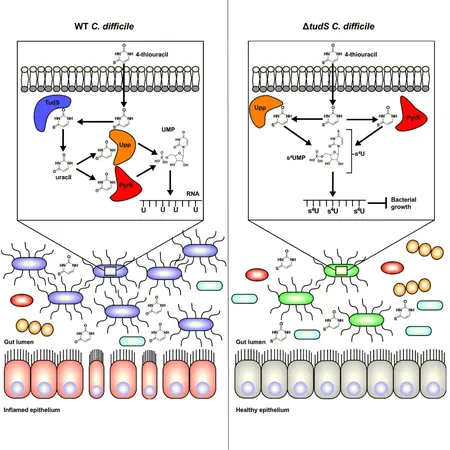
Researchers Uncover C. diff’s Tactic for Survival Amidst Gut Bacteria—A Toxic Secret Revealed!
2025-03-25
Author: Yu
Unveiling C. diff's Survival Strategy
In a groundbreaking study, researchers have unveiled a shocking strategy employed by the notorious pathogen C. difficile (C. diff), a leading cause of healthcare-associated infectious diarrhea. This bacterium possesses the remarkable ability to utilize a toxic compound, known as 4-thiouracil, to not only survive but also flourish in the human gut, thus gaining a decisive edge over beneficial microbes.
Details of the Study
Led by a team from Vanderbilt University Medical Center, the study intricately details how C. diff converts this harmful compound—often found in cruciferous vegetables like broccoli—into a vital nutrient. The research, published in the esteemed journal Cell Host & Microbe, sheds light on the molecular mechanics that enable C. diff to thrive during infections and opens pathways for innovative treatment strategies.
Impact of C. diff Infections
According to the Centers for Disease Control and Prevention (CDC), C. diff leads to an alarming half a million infections annually in the United States. Factors increasing the risk of such infections include antibiotic use, age (particularly individuals over 65), and recent hospitalization.
Research Insights
As the study's first author, graduate student Matthew Munneke, notes, "We're interested in trying to understand the nutrients that C. diff needs during infection and how dietary choices might affect its growth in your gut." The research team focused closely on nucleotides—the fundamental components of DNA and RNA—a category of nutrients that has avoided extensive scrutiny in relation to C. diff.
They identified that this pathogen requires specific nucleotides (known as pyrimidines) to instigate an infection and pinpointed an essential enzyme, TudS (thiouracil desulfurase), which allows C. diff to extract the nutritional benefits of uracil from 4-thiouracil.
The Toxic Advantage
What makes this finding even more alarming is that 4-thiouracil is toxic to most healthy gut microbes, but C. diff cleverly modifies and detoxifies it, using it as an exclusive nutrient source. The researchers demonstrated that in environments rich in 4-thiouracil, C. diff flourished over other bacteria. Remarkably, this metabolic advantage can further suppress competing bacteria, granting C. diff a festival of opportunities for survival.
Potential Therapeutic Targets
Importantly, the TudS enzyme could serve as a potential target for therapies aimed at combating C. diff infections, as it is not present in many beneficial gut microbes or human cells. This could pave the way for the development of antimicrobial drugs that selectively tackle C. diff while protecting healthy gut flora.
Probiotic Strategies
The study also demonstrated that incorporating C. diff's TudS into probiotic strains of E. coli could diminish C. diff’s competitive edge, hinting at viable probiotic-based treatments in the fight against this bacterial menace.
Dietary Implications
While it was confirmed that 4-thiouracil exists within the human gut, its exact origins remain unclear. It appears that livestock fed diets rich in cruciferous vegetables have increased levels of this compound, indicating that our dietary choices may inadvertently influence C. diff's presence.
Despite these findings, individuals should not abandon their diets rich in cruciferous vegetables just yet. Even in healthy guts, certain microbes can possess a TudS-related enzyme that enables them to transform 4-thiouracil into beneficial nutrients. Thus, it is possible that the absence of these microbes in C. diff-infected individuals exacerbates the problem.
Conclusion and Future Directions
Further investigations are imperative to fully grasp the origins of 4-thiouracil and to explore how dietary adjustments could play a role in the management of C. diff infections. The study represents a significant stride in understanding this persistent pathogen's tactics, potentially leading to more effective interventions and healthier gut microbiomes for everyone.




 Brasil (PT)
Brasil (PT)
 Canada (EN)
Canada (EN)
 Chile (ES)
Chile (ES)
 Česko (CS)
Česko (CS)
 대한민국 (KO)
대한민국 (KO)
 España (ES)
España (ES)
 France (FR)
France (FR)
 Hong Kong (EN)
Hong Kong (EN)
 Italia (IT)
Italia (IT)
 日本 (JA)
日本 (JA)
 Magyarország (HU)
Magyarország (HU)
 Norge (NO)
Norge (NO)
 Polska (PL)
Polska (PL)
 Schweiz (DE)
Schweiz (DE)
 Singapore (EN)
Singapore (EN)
 Sverige (SV)
Sverige (SV)
 Suomi (FI)
Suomi (FI)
 Türkiye (TR)
Türkiye (TR)
 الإمارات العربية المتحدة (AR)
الإمارات العربية المتحدة (AR)